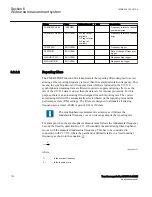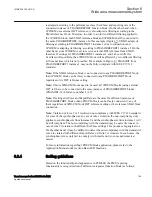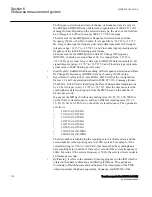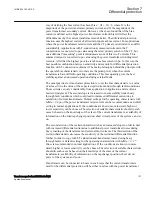
The frequency-deviation and rate-of-change-of-frequency data are sent via
the FREQ and DFREQ fields of data frame organization of IEEE C37.118.2
message format. Depends on the selected data type, the size of each field can
be 2 (Integer) or 4 (Float) bytes per IEEE C37.118.2 message.
The data sent via the FREQ field is frequency deviation from nominal
frequency (50 Hz or 60 Hz), in mHz. It is ranged from –32.767 to +32.767
Hz.
Integer
data type for frequency-deviation data represents 16-bit signed
integers, range –32 767 to +32 767 32, and
Float
data type represents actual
frequency value in IEEE floating-point format.
The data sent via the DFREQ field is Rate Of Change Of Frequency
(ROCOF), in Hertz per second times 100. It is ranged from –327.67 to
+327.67 Hz per second.
Integer
data type for ROCOF data represents 16-bit
signed integers, range –32 767 to +32 767 32, and
Float
data type represents
actual value in IEEE floating-point format.
•
SendFreqInfo
: Enables/Disables sending of the frequency-deviation and Rate
Of Change Of Frequency (ROCOF) data by choosing
On
/
Off
setting.
•
ReportRate
: It refers to the 2-byte DATA_RATE field of the configuration
frames 1, 2 and 3 organization defined in IEEE C37.118.2 message format.
The DATA_RATE field is identifying the Rate of phasor data transmissions
by a 2-byte integer word (–32 767 to +32 767). Here the user can select the
synchrophasor data reporting rate from the PMU based on the number of
frames per second.
In general, the IED has 5 different reporting rates (10, 25, 50, 100, 200 fr/s)
on the 50 Hz system frequency, and has 8 different reporting rates (10, 12,
15, 20, 30, 60, 120, 240 fr/s) on the 60 Hz system frequency. The options are
as follows:
•
10/10 fr/s (60/50Hz)
•
12/10 fr/s (60/50Hz)
•
15/10 fr/s (60/50Hz)
•
20/25 fr/s (60/50Hz)
•
30/25 fr/s (60/50Hz)
•
60/50 fr/s (60/50Hz)
•
120/100 fr/s (60/50Hz)
•
240/200 fr/s (60/50Hz)
The first number is identifying the reporting rate in a 60Hz system, and the
second number is the reporting rate in a 50Hz system. For example, if the
selected setting is
15/10 fr/s (60/50Hz)
, this means that the synchrophasor
data reporting rate would be 15 frames per second if the system frequency is
60Hz. Likewise, if the system frequency is 50Hz, the selected rate is equal to
10 frames per second.
•
RptTimetag
: It refers to the method of time-tagging used in the IED which is
related to the phasor estimation and filtering technique. The options are
FirstSample
,
MiddleSample
and
LastSample
. The time-stamp of the PMU
output represents the phasor equivalent, frequency, and ROCOF of the
Section 6
1MRK 504 163-UUS A
Wide area measurement system
132
Transformer protection RET670 2.2 ANSI
Application manual
Summary of Contents for RELION RET670
Page 1: ...RELION 670 SERIES Transformer protection RET670 Version 2 2 ANSI Application manual ...
Page 2: ......
Page 48: ...42 ...
Page 64: ...58 ...
Page 74: ...68 ...
Page 104: ...98 ...
Page 194: ...188 ...
Page 518: ...512 ...
Page 618: ...612 ...
Page 648: ...642 ...
Page 666: ...660 ...
Page 672: ...666 ...
Page 682: ...676 ...
Page 844: ...838 ...
Page 868: ...862 ...
Page 956: ...950 ...
Page 964: ...958 ...
Page 1004: ...998 ...
Page 1014: ...1008 ...
Page 1015: ...1009 ...






























